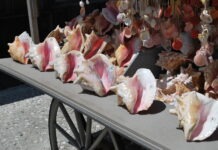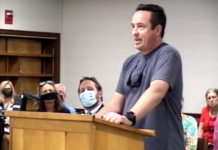
In the first 24 hours, the Monroe County Sheriff’s Office, with some assistance from Florida Highway Patrol, sent some 400 vehicles back north to the mainland via checkpoints on the 18-Mile Stretch in Key Largo and on Card Sound Road.
It’s the result of a measure implemented on the morning of March 27 that’s sending nonresidents of Monroe County out of the islands and back home in a bid to stave off community-spread coronavirus.
The checkpoint measure announced by the county on March 24 was ordered from 9 a.m. March 27 through 6 p.m. on Sunday, March 29. Now, a decision looms amongst the County Executive Decision Making Team on whether to extend the checkpoint, and if so, how long. That team is comprised of County Administrator Roman Gastesi, County Mayor Heather Carruthers, County Sheriff Rick Ramsay, County Emergency Management Director Shannon Weiner and County Fire Chief James Callahan.
“Their (the checkpoints) continuation is being reevaluated daily by the leadership group,” said Kristen Livengood, county spokeswoman, on Saturday. “Emergency Management will evaluate how the weekend check points worked.”
From Key Largo down south to the lower Keys, the checkpoint is yielding results — look no further than traffic through Islamorada at 1:30 p.m. on Saturday. What’s usually a bottleneck situation seen heading south at MM 90 — where two lanes turn to one — was all but a few lines of cars of five to seven throughout the afternoon.
Of those in support of a continued checkpoint is Islamorada Vice Mayor Ken Davis. He took to Facebook early Saturday morning stating that the village council voted unanimously to keep checkpoints in place.
“The checkpoint is proven to be effective, and there’s no reason why we should withdraw from it,” Davis told the Weekly. “While there’s a question regarding sustainability of personnel, we need to take every effort to keep it established.”
With 400 cars turned away, Sheriff Rick Ramsay said anywhere from 1,000-1,200 non residents were denied entrance to the Keys. Ramsay credits the early messaging regarding the checkpoints’ establishment.
“I spoke to the checkpoint not long ago. So far, a little over 100 this morning. So the numbers aren’t bad,” Ramsay told the Weekly just after 1 p.m. on Saturday, March 28. “Every person we keep out who is not supposed to be here only keeps the community safer. One person coming who’s infected can affect a large group of people, depending how close, how often, how long they’re here and how many people they’re interacting with. It’s a domino effect.”
“This is a decision for city, county leaders for sure,” Ramsay said on keeping the checkpoint going. “I think there’s a lot of support of the leaders and citizens to keep it going. But the challenge is most part Sheriff Office challenges and how we do this for long term?”
The biggest problem facing the checkpoint and its continuation? Ramsay said it’s manpower. Add to that the governor’s directive taking Florida Highway Patrol troopers away from local checkpoints, when local resources are already spread thin.
Per Gov. Ron DeSantis executive order dated March 27, the state of Louisiana was included in his list of hot spot states where residents who come to Florida must be isolated or quarantined for a period of 14 days from entry. FHP was directed to head up checkpoint enforcements into the state, which focus on the north end of the state (details as to specific locations weren’t divulged.)
Ramsay said the two local checkpoints had four troopers from FHP who assisted the sheriff’s office on March 27, before they were pulled away after two hours.
“That really hurt us. That was a surprise — that we were not getting assistance. And those troopers we were using were troopers assigned to Monroe County on shift, so they weren’t being pulled from other areas and weren’t on overtime costs,” he said. “They were assigned, allocated resources that were assigned to this county.”
Ramsay said they’re still hoping to get state resources, and he hopes the governor rethinks his decision to pull assistance to local checkpoints.
“That made it harder for me,” Ramsay said. “We’ve asked for National Guard and state law enforcement, and we’ve been denied. We were anticipating help from others, but we found ourselves destitute. This is around the clock staffing out there. We need 12-15 officers around the clock.”
Having spoken to Ramsay later in the day, Davis issued another Facebook message to the public urging them to email DeSantis and demand he commit state resources to the “health and welfare of Monroe County’s residents.”
“He (the governor) is not allowed to keep the Keys safe too?” Davis said in regards to the governor’s order in north Florida.
On top of manning two checkpoints, the sheriff’s office has also upped marine patrols. And add to that screenings at the airport by his staff as passengers arrive since there’s been no state health department staff allocated yet.
“We’re doing all the screening of the airport… (an airplane) came in with 27 people on a flight from Newark yesterday. The health department didn’t have staff to do it, so I had to have my staff do health screens at the airport,” he said.
They’re also expected to work on people who have illegal, short-term rentals, while ensuring restaurants and hotels and bars are in compliance with the shutdown and making sure people are staying off of a closed Higgs Beach. Ramsay said the office still has to do its prime objective of protecting life and property for day-to-day patrol service.
“We continue to have more and more work responsibility thrusted on us and put on our responsibilities,” he said. “I have to have proper staffing to respond to calls, to do proactive policing, to have fast response to calls, to backup other officers and to prevent, deter and investigate crime that may occur,” he said.
Just to the north and at the center of coronavirus cases in Florida are Broward and Miami-Dade counties. Combined the two account for just over 1,800 of the state’s 3,000-plus positive cases. Both counties have implemented stay-at-home policies.
Ramsay said with many of his officers residing in Miami-Dade, there’s concern for their health and safety.
“If this continues to be an epicenter in Dade, we can see ourselves having a reduction in our workforce who are either infected or need to be quarantined because they’re exposed to someone in their family,” he said. “We have to worry about what our staffing ratio will look like at one, two weeks, three weeks or a month.”
In her visit to the checkpoint on March 27, Carruthers noted that Monroe County’s COVID-19 infection rate was far less than that of neighboring counties, a factor that weighed in her decision to close the only two roads into the Keys. She said, “We’re running at about a less than 20% positive rate from the tests, and we hope to contain that. That’s precisely why we’re doing this. It’s our charge to protect our residents, and that’s what we’re trying to do.”
The mayor added, “Miami just did a stay-at-home declaration, so this is sort of our assistance with that. We’re gonna help you stay at home by taking away a little bit of the temptation to come to the Keys.”



























